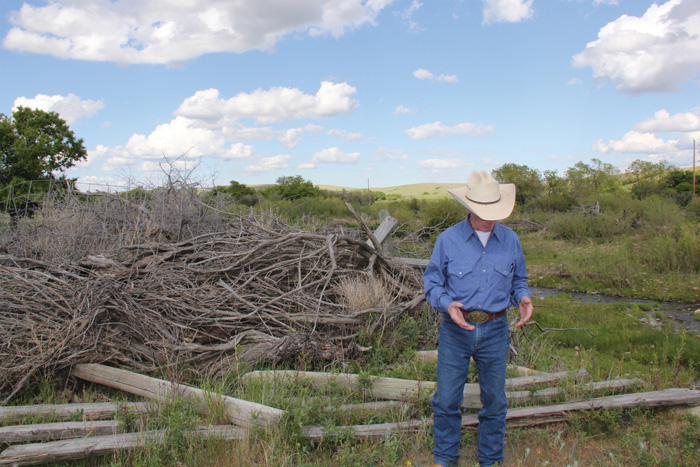I was on my way to Ravenscrag, Saskatchewan, on the last day of May this year when my wheel flew off.
I’d just driven through the Elrose Hills, rolling knolls dotted with oil tanks, and was watching the sky, wondering if it was going to rain. Then I realized that wobble in my Chevy Tracker was not its usual questionable handling. I lifted my foot from the gas and was just about to tap the brakes when it happened.
The Tracker’s rear driver’s side dropped suddenly. A rooster tail of sparks streamed up from the highway. I watched in amazement as my wheel passed me, cut through the oncoming lane (which was luckily traffic-free at that moment), and rolled into the ditch.
Read Also

Gentle treatments for pain in the neck
Heading toward year-end, people unknowingly tense up against the cold and busyness, causing neck pain that can often be treated with appropriate support and gentle mobility, athletic therapist Kathlyn Hossack says.
I felt oddly calm, even detached, as I geared down and slowly eased the Tracker to the side of the highway. And then annoyed as I retrieved my wheel from the ditch.
My Tracker, in the end, was towed to the small town of Kyle, which is about 70 km north of Swift Current. The tow truck driver regretted not being able to give me a ride to the Cypress Hills, which I thought was very generous considering he didn’t know me. He did help me buy a bus ticket.
In the end, though, I didn’t use that ticket. Instead, a local family put me up for the night and lent me a car the next day. They didn’t know me at all before bumping into me in Kyle. They insisted I take the car and refused payment (the wife told me she would be insulted if I tried to pay). And after spending some time with them, it became clear they had both gone through more than their share of trials, and not everyone they’d known had shown them the same kindness.
Ultimately it wasn’t just about them lending me a car for 10 days. They were saying that although they didn’t know me, they trusted me and wanted to help me. And that’s pretty amazing.
Weather, weather, weather
Whether you’re on the livestock or crop side of agriculture, you’re acutely aware of the weather. So it’s no surprise this awareness threaded its way through my travels this summer.
When I arrived in the Ravenscrag area, in the eastern Cypress Hills, the hills were dry. Jim Saville, the proprietor of the bed and breakfast, I called home for a few days, was watching the sky closely, hoping for rain to revive pastures and hayland.
It was dry in the Maple Creek area, too, which is west of Ravenscrag. Environment Canada data showed only 40 mm of precipitation for April and May — far below the 30-year average of 72 mm. And June’s rainfall was also well below average.
The Cypress Hills see its share of wild weather, too. While I was there I witnessed a severe, localized hailstorm that stripped leaves from the trees and pummeled the pasture. And I was part of a farm media tour that visited Eric Lawrence, who ranches just south of Maple Creek. Gap Creek runs through the Lawrence ranch and during the 2010 flood it turned into a destructive torrent. The water washed away some of Eric’s cultivated land and turned the creek bottom fencing into a complete rat’s nest.
I’ve never had to clean up barbed wire after a flood, but it’s clearly a very difficult task and a livestock hazard. I can’t imagine the mess many flooded Prairie producers must be dealing with again this year.
Severe weather puts people at risk, too. Every year lightning kills about 10 people in Canada and injures another 100 to 150, Environment Canada’s website states. Plough winds are fairly common on the Prairies. Few people are killed by tornadoes in Western Canada, but Saskatchewan storm chaser Greg Johnson said we have plenty of tornados. They just tend to hit more crops and trees than people.
Environment Canada doesn’t communicate severe weather to the public very well, Johnson told me during an interview at Canada’s Farm Progress Show in Regina this June.
“Environment Canada has a philosophy of what we call the pull method, where they encourage people to pull the information away from Environment Canada,” he said.
In the United States, by contrast, the National Weather Service pushes warnings to people in areas about to be hammered, he said. Sirens blare, TV and radio are legislated to broadcast warnings and the weather service even texts and tweets people at risk.
“We’ve been in tornado situations where people literally have time to go to the school, pick their kids up, bring them back, get them in the storm shelter,” said Johnson of the U.S. system.
It’s easy to dismiss funding for better severe weather warnings in Western Canada by pointing out the relatively low death toll so far. But with all the outdoor festivals jammed into summer, a better warning system is needed. A plough wind killed one person and injured dozens of others at Alberta’s Big Country Jamboree five years ago. Environment Canada had issued a severe wind warning just as the winds hit the festival. Maybe festival organizers and attendees could have averted that tragedy if they’d had more warning.
And while some media broadcast warnings and watches, not everyone is glued to their TVs or radios these days. I always have the radio on, but because I don’t have good reception in my house, I stream it online. So if the power goes out, I’m in the dark. I imagine farmers in the field would appreciate warnings sent directly to their cell phones, too.
The good news is that Environment Canada plans to improve its weather warning system. Ken Macdonald, Environment Canada’s director of national programs, told CBC he hopes to see a mobile alert system in Canada within a couple years. And the government is considering making it mandatory for media to broadcast weather alerts, as it’s voluntary right now, he said.
Never a boring day
If you get a chance to talk to Johnson, or see him speak, you’ll notice that his love of storm chasing stands out.
“I see a tornado on the ground, I’m excited. It’s a euphoric feeling,” he told me. And most tornadoes are tragedy-free, touching down in fields well away from people.
“But every once in a while you get that tornado that rips through a town like Vilonia (Arkansas)… And in those situations obviously the emotions instantly change,” Johnson said.
Johnson and his team were the first people to arrive after a tornado shredded Vilonia and ultimately killed 16 people last April. The town was shrouded in darkness when they arrived, and as their truck’s headlights carved through the night, survivors gathered around their truck.
Johnson, driver Ricky Forbes, and videographer Chris Chittick started to administer first aid. Emergency personnel were still in Mayfield, a neighbouring community levelled by the same twister a half hour earlier.
Once others arrived to tend the wounded, Johnson, Chittick and Forbes began digging through the wreckage to find survivors. They found a family with an infant who’d been trapped for hours. They found a woman with a possible spinal injury, so one team member stabilized her neck for hours until more help arrived.
Obviously what they did that day was very important. They helped people in crisis. They probably saved lives. But what they did was more important than the sum of their actions.
By helping people, they were saying, “Even though we don’t know you, we care about you. Your life is important.”

















